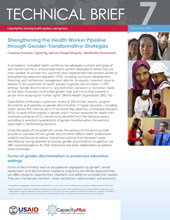
New Publication Spotlight: Strengthening the Health Worker Pipeline through Gender-Transformative Strategies
To build a strong health workforce, many countries are working to improve the quality of preservice education by updating curricula and strengthening school management. But an area that gets less attention concerns the barriers presented by gender discrimination.
A new CapacityPlus technical brief, Strengthening the Health Worker Pipeline through Gender-Transformative Strategies, describes how certain forms of gender discrimination affect health professional students and faculty, and presents ways to counter the problem. Authors Constance Newman, Crystal Ng, and Sara Pacqué-Margolis recommend specific actions that preservice education stakeholders can take at the institutional and governmental levels.
Why focus on preservice education?
In the field of health systems strengthening, says Ng, “gender discrimination doesn’t get that much attention, but when it does it often focuses on health workers in the workplace. Yet there are also reasons why people might not even get into the workforce due to gender-related barriers that interfere at earlier stages in a health worker’s career—obstructing a country’s pipeline of new health workers from the start.” What’s a gender-transformative strategy?
What’s a gender-transformative strategy?
Gender-transformative interventions actively strive to examine, question, and change rigid gender norms and imbalances of power as a means of reaching health objectives as well as gender-equity objectives. “We propose six criteria for gender-transformative strategies in preservice systems, which can be used to identify interventions that are likely to counter or eliminate discrimination based on gender,” says Newman.
An example of a transformative strategy is child care. “Offering child care in the workplace,” says Ng, “is transformative in that it places equal value on being a professional and being a caregiver. It [makes a statement that] women have an equal right to be working as men do—people aren’t defined by their domestic responsibilities.” Pacqué-Margolis explains, “Caregiving has been perceived as a woman’s [natural] role, which plays into stereotypes associated with each gender that then affect women in the workplace. Offering child care at work counters traditional stereotypes that a woman’s place is in the home by recognizing that caregiving roles have equal value in the workplace. It recognizes the needs of parents who might otherwise have to take time off from their studies or their teaching.”
One intervention isn’t enough
The authors describe how “basic bundles” of interventions are the best prospects for potential transformation, rather than just one on its own. For example, while it’s a good start for a school to have a policy prohibiting sexual harassment, it’s more effective to combine it with other interventions. To make the policy really count, says Ng, “it needs to be supported by a grievance mechanism and also by training so that staff and students understand roles and expectations. We saw in quite a few instances [in our review of institutions] that having a sexual harassment policy didn’t necessarily mean that things changed. And some institutions put together a grievance procedure so students or staff could lodge a complaint that would in theory be heard, but in some cases the committee didn’t meet often enough to hear the complaint. In other institutions there wasn’t a strong mechanism to prohibit retaliation, so people may have been afraid to use it or didn’t know about it.”
Learn more
To learn more, read the technical brief—available as an interactive version and a PDF—and the accompanying full report. And please let us know what you think; we welcome your feedback.
Related items:


